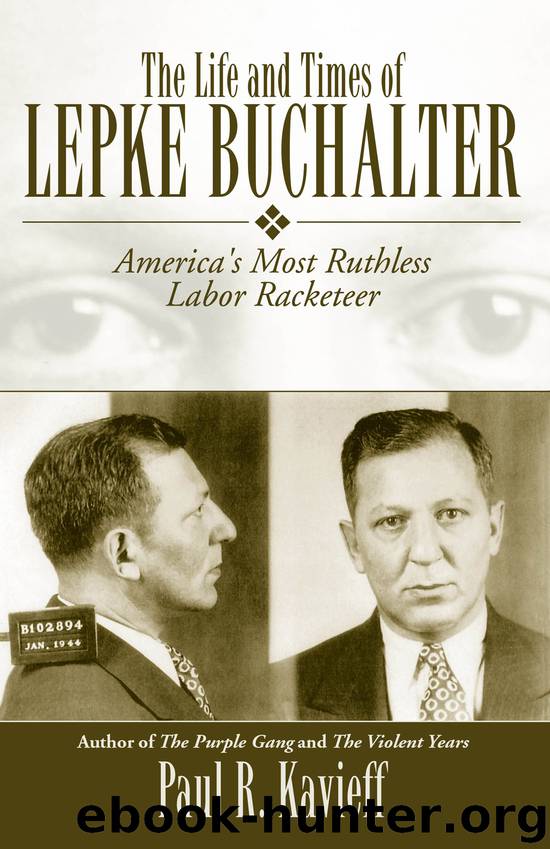The Life & Times of Lepke Buchalter by Paul R. Kavieff

Author:Paul R. Kavieff
Language: eng
Format: epub
ISBN: 9780934878470
Publisher: Barricade Books
Published: 2015-02-08T16:00:00+00:00
10
Trials and Tribulations
“The smuggling of narcotics deserves stem punishment. The leaders of the gangs in violating Federal laws prey on the moral and physical fiber of their victims in dealing with habit forming drugs that eventually destroy addicts.”1
In December 1939, Lepke went on trial in U.S. federal court on the drug-smuggling charges that had been pending against him since 1937. Most of his coconspirators had been tried, convicted, and sentenced while Lepke was a fugitive. These codefendants included Jacob “Yasha” Katzenberg, who had agreed to testify against Lepke in return for a lesser sentence.
One of the first witnesses to take the stand against Lepke was a tough mobster who had feigned allegiance to Lepke and then went home at night to keep books on the accused gangster’s $ 10-million international narcotics-smuggling racket. In reality, he was a federal agent. Al Kearns, the undercover man, sat at the side of Assistant U.S. Attorney Martin as the prosecutor outlined the methods by which the $ 10-million worth of narcotics were imported into the country between 1935 and 1937. Martin explained how the gigantic ring bought narcotics in China and shipped them via Marseilles, Bordeaux, and Cherbourg. The drugs originated in Tientsin, China, from a factory supposedly operated by Chinese army officers.
It was told how Lepke made no specific agreement with Katzenberg, but just muscled into the smuggling ring. “That’s my connection you’re using,” Buchalter was quoted as saying to Katzenberg. Katzenberg agreed. “I want my share,” Buchalter demanded. He first put himself down for 60 percent and later settled for 50 percent. The importing system worked smoothly with the help of a Japanese doctor on one end, two Greek businessmen in the middle, and Customs Inspector John McAdams at the Port of New York providing the necessary customs stamps.2
Mr. Martin, in an hour-and-a-half recital of the syndicate’s operations, conceded that Lepke, who until then had restricted himself to large-scale industrial rackets, wanted no part of the narcotics racket at first. It was only after the ring successfully smuggled its first trunkload of narcotics into the country, with its own members slapping customs stamps on the trunks, that Lepke became interested. Then, according to Mr. Martin, Lepke went to Katzenberg and demanded his cut.
So that there would be no question as to what constituted 50 percent of a shipment, Lepke arranged that half of each shipment brought into the country by the couriers was to be turned over immediately upon arrival to a Lepke lieutenant named Louis Kravitz. Kravitz was named as a defendant in the indictment, but at that time was a fugitive.
According to testimony, the ring had two sources of supply in China. One source was an illicit drug factory in a Shanghai airplane hangar. The other source was a Dr. Santsuki of Kobe, Japan, whose price list was reported to contain every variety of opiates known to man. Once the couriers arrived in Shanghai, they would contact the drug ring’s representative through a Greek family who lived there.
The syndicate sent attractive women or respectable-looking men to Shanghai to meet the ring’s representative.
Download
This site does not store any files on its server. We only index and link to content provided by other sites. Please contact the content providers to delete copyright contents if any and email us, we'll remove relevant links or contents immediately.
| Mid Atlantic | Midwest |
| New England | South |
| West | Kindle Edition |
| Large Print | Audible Audiobook |
| Audio CD | Board Book |
Kitchen confidential by Anthony Bourdain(2325)
Dry by Augusten Burroughs(1692)
I Know Why the Caged Bird Sings by Maya Angelou(1597)
Kitchen Confidential by Anthony Bourdain(1534)
KITCHEN CONFIDENTIAL Adventures in the Culinary Underbelly by Anthony Bourdain(1454)
A Child Called It by Dave Pelzer(1413)
I know why the caged bird sings by Maya Angelou(1378)
A Heartbreaking Work of Staggering Genius by Dave Eggers(1369)
Taken by J. C. Owens(1285)
all by Unknown Author(1247)
Zeitoun by Dave Eggers(1229)
Extraordinary, Ordinary People by Condoleezza Rice(1212)
A Stolen Life by Dugard Jaycee(1161)
House of Darkness House of Light by Andrea Perron(1160)
The Farm in the Green Mountains by Alice Herdan-Zuckmayer(1145)
Law Man by Shon Hopwood(1143)
The Big Sea by Langston Hughes(1095)
The Year of Yes by Maria Headley(1072)
Dewey: the Small-Town Library Cat Who Touched the World by Vicki Myron & Bret Witter(1016)
